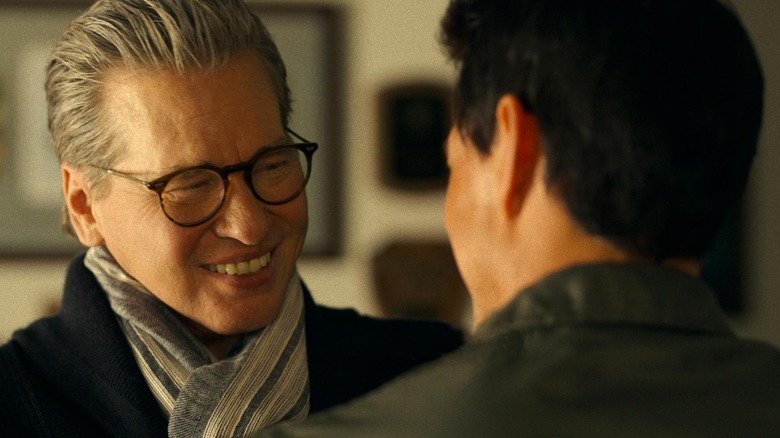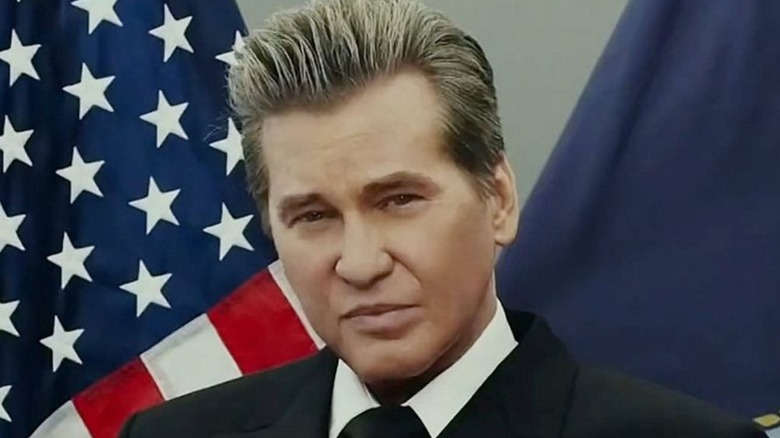Top Gun: Maverick's Iceman Scene Became Much More Powerful Thanks To A Key Decision [Exclusive]
Given his penchant for star vehicles like "Tombstone" and "Batman Forever," it's easy to forget that Val Kilmer is a classically trained actor who was the youngest person ever to be accepted into the Drama Division at Julliard. If it wasn't for his leading man good looks, Kilmer might have become more of a character actor instead of a marquis draw. Deep down, he's a man of the theatre who approached all of his roles as if he was performing them in the round at Shakespeare's Globe in London. Iceman in "Top Gun" is not a meaty role on paper, but the commitment to the art of acting allowed Kilmer to make every one of his scenes count.
Pete "Maverick" Mitchell (Tom Cruise) wouldn't have grown into the pilot he became if Iceman wasn't always hot on his tail. As a result, the long-awaited sequel "Top Gun: Maverick" had to feature Iceman in some capacity, so much so that Cruise wasn't sure he even wanted to make a follow-up that didn't address the relationship between the two fighter pilots.
Kilmer's memoir "I'm Your Huckleberry" and the emotionally raw Amazon Prime documentary "Val" both painfully detail the actor's battle with throat cancer that resulted in the loss of his voice, a tragic outcome for anyone but especially so for an actor of Kilmer's caliber. The scene where Captain Pete "Maverick" and Admiral Tom "Iceman" Kazansky do finally reunite had to be done delicately, considering audiences were probably anticipating the moment even more than the daring aerial acrobatics seen in the finished film.
Kilmer's real-life battles were highly publicized, so fans were incredibly curious how the filmmakers were going to pull off a satisfying reunion. The effectiveness of the scene really comes down to a single line uttered by Iceman.
'That scene had to deliver'
The impact of Kilmer's performance wouldn't have had the same resonance, perhaps, if every word of dialogue was spoken. /Film's Jack Giroux spoke with "Top Gun: Maverick" editor Eddie Hamilton about retooling the emotional scene:
"Though it was difficult, we trod very carefully and we refined it endlessly. Again, we felt the weight of expectation. That scene had to deliver. It had to thread this needle for the audience, who know that Val Kilmer has had health issues and can't speak very well, so they're like, 'Well, how are they going to handle this?' I remember reading a version of the scene where he spoke every line of dialogue and didn't type it, and we filmed it just in case."
Having as much coverage as possible in such a crucial exchange was a smart thing for Hamilton and director Joseph Kosinksi to have in their back pocket, just in case. They ultimately went with the more dramatic choice. He continues:
"But I remember talking to Joe [Kosinski] and saying, 'Look, if he only says one thing right at the end of the scene and it takes enormous effort then to say it, it will have so much more resonance and you'll feel so much more from the scene between those two characters.' So we ended up finding that."
Between the edits, the changes in the script, and the palpable connection between Cruise and Kilmer, the scene is powerful and engaging. Through all the years it took to literally get "Top Gun: Maverick" off the ground, the connection between the actors and an audience that grew up with them has fused together to create a legitimate bond. They walked a balance beam in that scene and managed not to fall too much into saccharine sentimentality.

